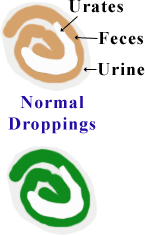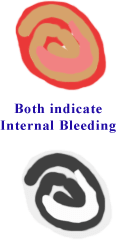Poopology
..often the first sign of illness
by Myra
Articles and Information - Lady Gouldian Finch
This topic may be a little disgusting to some of you, if you have a weak stomach or find the tedious examinations of your birds droppings nauseating I suggest you turn back now. For the rest of you, let's go check out the poo.
Everyone knows a bird is sick when you see it sitting still, looking depressed with the feathers all disheveled. The problem is, that description alone is only a tiny fraction of the puzzle to diagnosing what is wrong with your bird. As you already know, treating the symptoms never works; you must find the cause and treat that if you have any chance of saving your birds life. Often finding the cause can be as simple as taking a closer look at your birds' fresh droppings.
 White Urates - nutty brown to green droppings - Normal
White Urates - nutty brown to green droppings - Normal
Practice observing your birds droppings first.
(please pardon my crude poo drawings)
Hopefully your bird is quite healthy right now and this is the perfect time to practice poop observation. Use a plain print newspaper, white paper or wax paper on the floor of your birds cage so you can see the droppings clearly. Once you have an idea what healthy droppings look like you'll have little trouble spotting the signs of illness later.
If you normally use pine shavings, corn cob, pellets or any of those other fancy floor coverings you will find it very difficult to keep an eye on the droppings. I don't mind that you do use these materials but once a month or so you should switch to paper so you can note any unusual changes in the droppings.
What is all that stuff in the droppings?
Bird poop is actually quite remarkable in it's own right because all forms of waste are expelled at once in one tidy little blob. There are 3 parts to that blob and you much learn to tell them apart of this article is to be of any use to you.
Urates are the crystalline section of the urine. This part will appear chalky white and has a consistency that isn't really watery or solid. As close as I can describe the constancy would be good old Elmer's' glue, just not as adhesive.
Urine is the clear part and is like water. In fact it's not much different than anyone other animals pee. Sometimes the Urine and Urates will mix and form a cloudy liquid, don't be alarmed if you can't always tell the two areas apart.
The Feces is the third part and it's the only real solid part. It'll be that tubular shaped section in the middle of the dropping. It may be straight, coiled, of even broken up in to smaller yet still tube shaped pieces.
 | Normally inconsistent or consistently abnormal?
The one thing to remember with droppings is they will normally be inconsistent when healthy. This is due to the fact that a healthy bird will be eating a rich and varied diet. When ill the droppings will be consistently abnormal. |  |
Color and consistency can indicate health problems.
Always remember that diet, stress and environment will have a natural effect on your birds' droppings.
 Yellow urates, green poo possible liver, brown urate possible lead poisoning
Yellow urates, green poo possible liver, brown urate possible lead poisoning
In times of stress the droppings will naturally be more watery. This is due mostly to the birds fight or flight instinctual response. When in a panic birds will expel any waste in their system prior to taking flight. More Urine and Urates are produced than feces each day. If the stress is ongoing the majority of the droppings will have very little feces in them, if any at all.
You'll also notice a lot more urine in the droppings if your bird is drinking excessively or eating foods high in water. Lettu>>ce and fruits are very high in water and are the most common cause for watery droppings. Even birds that enjoy bathing frequently may have watery droppings because as they are preening off the bath water they will ingest some of it.
The color of feces may change from time to time depending what your bird has eaten recently. Seeds and green veggies will naturally produce green feces while blueberries and blackberries produce black feces. If you feed your bird a pellet diet the feces will often be the same color as the pellet if they are colored or a rusty color if they are not colored. If you think your birds feces looks wrong keep the diet simple (back to seeds) for a day and re-check. Thankfully the bird digestive system works very fast and you'll have any odd food induced colors worked out of the body fairly quickly.
Urates (the chalky white part)
Green: Liver Disease or Anorexia
Yellow: Liver Disease or Anorexia
Brown: Lead Poisoning
Red: Internal Bleeding (low in the digestive track) or Kidney Disease
Increased Urates: Dehydration and possible kidney problems
Urine (the clear watery part)
Green: Liver Disease
Yellow: Liver Disease
Red: Internal bleeding (low in the digestive track), Lead Poisoning, Kidney Disease
Increased Urine: Drinking a lot, Eating foods high in water or Disease (often bacterial)
 White Urates - nutty brown to green droppings - Normal
White Urates - nutty brown to green droppings - Normal
Feces (the solid tubular part)
Black or Tar-like: Internal bleeding (high in the digestive track)
Pea Green: Liver Damage
White or Clay color: Pancreas or digestive problems
Lumpy or Undigested food: Incomplete digestion, Giardia, hypermotile intestine.
Always remember to keep an eye out for worm segments in your birds' droppings.
Diarrhea:
When a bird has Diarrhea the feces will be soft and will not be the typical tubular shape.
Polyuria:
Polyuria is harder to spot in finches. With parrots the droppings will be extremely watery yet the feces will be intact. Finches don't always exhibit the excessively watery droppings. Often the first sign that this illness is in your flock is when your finch drops dead suddenly. This illness is often fatal and has the most profound effect on young chicks. The few chicks that do survive to adulthood often develop poor feathering and beak malformations. The only way to know if Polyuria is in your flock is with Veterinarians assistance. Polyuria may be caused by viral infection, stress, and kidney disease or poisoning.
Should the droppings smell?
No. Never. Healthy birds' droppings have no noticeable odor if they are fresh. A fowl smell is often a sign of infection in the digestive track. Most commonly it'll be a bacterial or yeast infection.
Now if the droppings have been sitting around and stay moist due to bathing birds or humidity then it is possible things will get a little smelly over time. If you clean your birdcage regularly this will not become a problem.
Oh, what to do...
Once you have a fairly good idea what is ailing your bird, you need to begin treatment. In some cases this is as simple as adjusting your birds diet. In other cases treatment with any hope of a cure isn't possible. In extreme cases of kidney, liver failure or internal bleeding your bird may never recover. When in doubt always consult your local avian veterinarian.
When dehydrated encourage your bird to drink or bathe. If that doesn't work use foods like Lettuce, fruit or even cooked rice to get extra water in to your bird. Do not pry open your birds beak and attempt to force water down its' throat, this will almost always lead to aspiration and death. The only time you can attempt this is with a crop tube and even then I do not recommend you put pure water in to the crop. Rather mix up a thin mixture of hand feeding formula so the bird is less likely to regurgitate and aspirate.
If the droppings aren't quite right but you can't pinpoint the problem either, you may want to try a few simple remedies. First I recommend Guardian Angel. This supplement boosts the immune system and helps the bird to heal itself. The second is Energise to give the bird back the extra energy it needs to recover more quickly. Finally Hearty Bird to bring your birds diet back in to balance in order to prevent the problem from returning.
Legal Disclaimer..
Terri's Glamorous Gouldians is not licensed to provide veterinary services.Nothing contained in the site is intended to replace the services of a licensed, trained physician or health professional or to be a substitute for medical advice of a veterinarian or trained veterinary professional.
© lady gouldian finch.com 2017